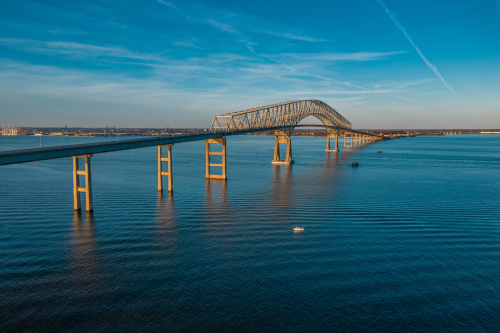
NTSB: Baltimore Bridge Disaster Caused Hazmat Spill
Jennifer Homendy, Chair of the National Transportation Safety Board (NTSB), has revealed that the cargo ship Dali that brought down the Francis Scott Key Bridge in Baltimore early Tuesday morning was carrying 56 containers of hazardous materials.
The dangerous material totaled 764 tons, including corrosives, flammables and lithium-ion batteries. At least some of these containers were breached during the crash. As witnesses have seen a sheen of chemicals on the waterway surrounding the collapsed bridge, experts are raising alarms of a potential environmental disaster.
The NTSB is actively investigating and currently focusing on collecting perishable evidence. Homendy described the scene as “pretty devastating.”
In the wake of the disaster, concerns have risen over the economic implications of the bridge’s collapse. The Port of Baltimore, a critical trade hub, has been shut down, affecting over 8,000 jobs and halting the daily movement of goods valued at over $100 million. Transportation Secretary Pete Buttigieg expressed concern about the local economic fallout from the port’s closure.
National Transportation Safety Board (NTSB): Hazmat containers breached during bridge collapse https://t.co/dPJmsg09vI pic.twitter.com/0lZsBHG8IA
— The Hill (@thehill) March 28, 2024
Joe Biden has committed to ensuring that the federal government will fully fund the bridge’s reconstruction, recognizing its vital role in the nation’s infrastructure and economy. “It is my intention that the federal government will cover the full cost of rebuilding the bridge,” Biden stated, emphasizing the importance of legislative support for this effort.
The incident has prompted calls for revisiting regulatory and permitting processes for infrastructure projects. GOP Rep. Mike Collins of Georgia highlighted the need to reduce the regulatory burdens of the National Environmental Policy Act (NEPA) to expedite the bridge’s reconstruction and improve the permitting process for all infrastructure projects.
The Baltimore bridge disaster underscores a pressing need for swift action and regulatory reform. The immediate environmental and economic impacts are undeniable, with hazardous materials leaking into the harbor and closing a vital economic artery.
Moreover, the response from political leaders, particularly President Biden’s commitment to fund the reconstruction, reflects an awareness of the broader implications of such infrastructure failures. The disaster has brought to light the critical nature of efficient and expedited processes for infrastructure development and repair, highlighting the necessity for regulatory reform that GOP Rep. Mike Collins advocates.
As the NTSB releases its preliminary report in the coming weeks, it will be crucial to focus on the lessons learned from this tragedy. The importance of resilient infrastructure, swift emergency response, and environmental safeguarding cannot be overstated. The disaster at the Francis Scott Key Bridge should act as a catalyst for significant infrastructure and regulatory reform, ensuring the safety, efficiency, and environmental integrity of our nation’s critical assets.